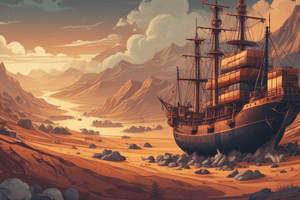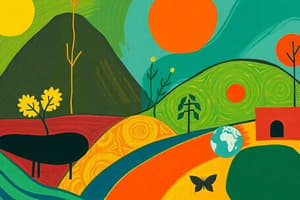Podcast
Questions and Answers
What is the primary cause of scarcity in economics?
What is the primary cause of scarcity in economics?
- Low production efficiency
- Market fluctuations
- Temporary shortages of goods
- Unlimited human wants (correct)
How does a shortage differ from scarcity?
How does a shortage differ from scarcity?
- Scarcity is a universal economic fact, while a shortage is a temporary imbalance. (correct)
- A shortage is caused by unlimited wants, while scarcity results from limited resources.
- Scarcity only affects poor societies, while shortages can affect any.
- A shortage is permanent, while scarcity is temporary.
What does economic efficiency aim to achieve?
What does economic efficiency aim to achieve?
- Reduction of resource consumption.
- Equal distribution of resources among society.
- Maximization of profits for businesses.
- Satisfaction of as many needs and wants as possible. (correct)
Which of the following concepts is closely related to scarcity?
Which of the following concepts is closely related to scarcity?
What is equity in the context of economic resources?
What is equity in the context of economic resources?
Which is a measure of improving production to address scarcity?
Which is a measure of improving production to address scarcity?
Which situation signifies an understanding of economic scarcity?
Which situation signifies an understanding of economic scarcity?
What is likely to happen in the market when there is a temporary shortage?
What is likely to happen in the market when there is a temporary shortage?
What is the primary focus of the 'Right to Redress' for consumers?
What is the primary focus of the 'Right to Redress' for consumers?
Which consumer right ensures that individuals can voice their complaints regarding consumer protection laws?
Which consumer right ensures that individuals can voice their complaints regarding consumer protection laws?
What does the 'Right to Healthy Environment' signify for consumers?
What does the 'Right to Healthy Environment' signify for consumers?
Which of the following factors is considered a factor of production?
Which of the following factors is considered a factor of production?
What aspect of consumer rights does 'Consumer Education' address?
What aspect of consumer rights does 'Consumer Education' address?
What does scarcity compel individuals to do?
What does scarcity compel individuals to do?
What is meant by the term opportunity cost?
What is meant by the term opportunity cost?
In the context of opportunity cost, if a student chooses to review for an exam instead of attending a concert, what is the opportunity cost?
In the context of opportunity cost, if a student chooses to review for an exam instead of attending a concert, what is the opportunity cost?
What does the production-possibility frontier (PPF) illustrate?
What does the production-possibility frontier (PPF) illustrate?
Which of the following scenarios best represents the concept of choice due to scarcity?
Which of the following scenarios best represents the concept of choice due to scarcity?
In an economy represented by the PPF, if resources are utilized efficiently, this means:
In an economy represented by the PPF, if resources are utilized efficiently, this means:
Which example best illustrates opportunity cost?
Which example best illustrates opportunity cost?
Which factor does NOT influence the position of the production-possibility frontier?
Which factor does NOT influence the position of the production-possibility frontier?
Which of the following is classified as a non-metallic natural resource?
Which of the following is classified as a non-metallic natural resource?
What comprises physical capital?
What comprises physical capital?
Which of the following is NOT considered human capital?
Which of the following is NOT considered human capital?
How does scarcity affect individuals?
How does scarcity affect individuals?
What is the primary role of human capital in the context of physical capital?
What is the primary role of human capital in the context of physical capital?
Which of the following best describes scarcity?
Which of the following best describes scarcity?
Inventory in a business typically refers to what?
Inventory in a business typically refers to what?
Which of the following is NOT a function of capital resources?
Which of the following is NOT a function of capital resources?
Which factor does NOT significantly affect consumer consumption?
Which factor does NOT significantly affect consumer consumption?
What is a characteristic of 'pakikisama' in Philippine consumer culture?
What is a characteristic of 'pakikisama' in Philippine consumer culture?
Which type of advertisement emphasizes the manufacturer's reputation?
Which type of advertisement emphasizes the manufacturer's reputation?
What is the 'Right to Proper Information' as a consumer right?
What is the 'Right to Proper Information' as a consumer right?
Which factor describes the preference for foreign goods over local products in Philippine culture?
Which factor describes the preference for foreign goods over local products in Philippine culture?
How does the 'Bandwagon' advertisement technique operate?
How does the 'Bandwagon' advertisement technique operate?
Which right specifically protects consumers from harmful products?
Which right specifically protects consumers from harmful products?
What consumer behavior is associated with regionalism?
What consumer behavior is associated with regionalism?
Flashcards are hidden until you start studying
Study Notes
Natural Resources
- Natural resources are categorized as non-metallic (e.g., oil, molave tree, round scad) and metallic (e.g., copper, iron, gold).
Capital Resources (CR)
- Capital resources are classified into physical capital and human capital.
- All capital resources are employed to create goods and services.
Physical Capital
- Comprises structures (e.g., factories, offices, restaurants, warehouses), equipment (e.g., tractors, ovens, machinery), and inventory (raw materials and finished goods available for sale).
- Structures facilitate production.
- Equipment aids in transforming resources into finished goods.
- Inventory constitutes the stock of materials used in production.
Human Capital
- Refers to individuals employed by businesses based on their skills.
- They operate machinery, cook, provide healthcare, etc.
- Human capital is essential; without people, physical capital becomes ineffective.
Scarcity and Choice
- Scarcity occurs when resources are insufficient to meet unlimited human wants.
- Individuals and societies experience scarcity, leading to the need for rational resource allocation.
Scarcity vs Shortage
- Scarcity is a permanent economic condition affecting all, while a shortage is a temporary imbalance in the supply-demand equation.
- Steps to address scarcity may include improved technology or resource reclamation.
Dealing with Scarcity
- Scarcity necessitates efficiency, choice, and opportunity cost.
- Efficiency: The effective use of limited resources maximizes the satisfaction of needs and wants.
- Choice: Scarcity forces individuals to prioritize which wants to satisfy, leading to select alternatives.
- Opportunity Cost: Represents the value of the foregone alternative when choosing one option over another.
Production-Possibility Frontier (PPF)
- The PPF graphically represents the maximum output combinations an economy can produce given its resources and technology.
- Illustrates the trade-offs and opportunity costs involved in production decisions.
Consumer Products
- Goods and services designed to meet personal needs.
- Consumer Services: Services that enhance or repair consumer products (e.g., restaurants, repair shops).
Factors Affecting Consumption
- Income, occasion, seasons, prices, trends, and bandwagon effect influence consumer behavior.
Consumption in Philippine Culture
- Pakikisama: Tendency to buy from relatives or friends even if unnecessary.
- Colonial Mentality: Preference for foreign goods over local products.
- Regionalism: Preference for goods produced within one’s locality.
- Tradition: Consumption influenced by cultural beliefs and practices.
Advertising
- Advertising informs consumers about products and raises demand.
- Types of ads:
- Brand Ads: Emphasize manufacturer’s reputation.
- Testimonial Ads: Utilize celebrity endorsements.
- Scare Ads: Create a sense of urgency around not purchasing.
- Bandwagon Ads: Capitalize on trends.
Consumer Rights
- Right to Basic Needs: Access to essential goods and services (food, clothing, shelter, healthcare).
- Right to Safety: Protection against harmful products.
- Right to Information: Access to accurate product information.
- Right to Choose: Freedom to select from various products.
- Right to Representation: Opportunity to voice consumer concerns.
- Right to Redress: Seek compensation for faulty products.
- Right to Consumer Education: Awareness of rights and protections.
- Right to a Healthy Environment: Right to a safe and sustainable living environment.
Consumer Responsibilities
- Ethical consumption practices encourage informed and responsible purchasing decisions.
Essence of Production
- Production involves utilizing resources to create goods and services that fulfill needs and wants.
Factors of Production (Inputs)
- Refers to the resources or inputs necessary for producing goods and services.
Studying That Suits You
Use AI to generate personalized quizzes and flashcards to suit your learning preferences.




